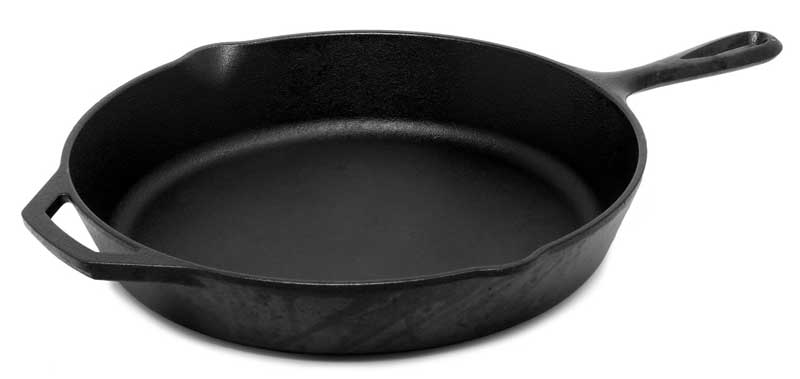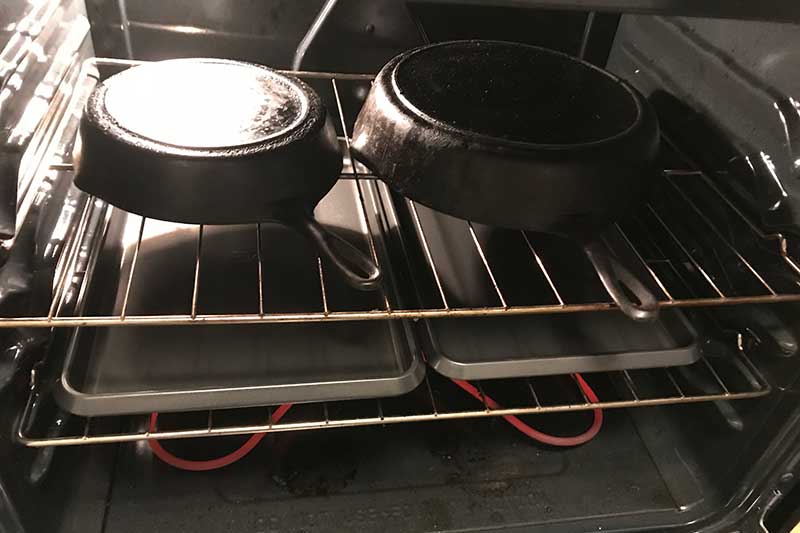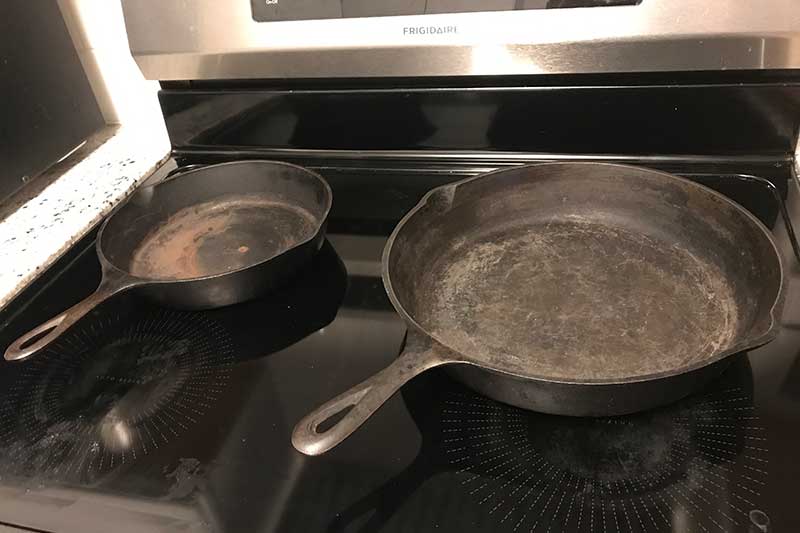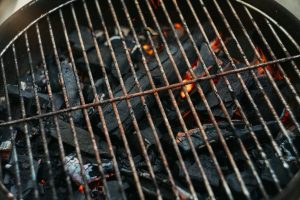This page may contain affiliate links. If you click and buy, we might get a small commission at no cost to you.
Cast iron skillets are durable pans that will last for generations. The pan heats evenly and stays hot keeping food warm until you’re ready to eat. Once the skillet is seasoned, you’ll find that almost nothing sticks to the bottom. Everything from eggs to bread slides easily off a cast iron skillet. In this article, we’ll learn how to clean a cast iron skillet after use.
The key to cooking with cast iron pans is the seasoning. It’s what gives the skillet its non-stick finish. Lose the seasoning, and everything sticks to the pan. It’s the fastest way to ruin a cast iron skillet.
How to clean a cast iron skillet after use
You don’t want to lose the pan’s seasoning. You can re-apply it, as long as you haven’t used the pan. It takes a while to reapply, which means you can’t use the skillet. The fastest way to ruin the coating is to toss it in the dishwasher. Soap removes the seasoning. You also don’t want to use dish soap when you’re washing the pan by hand.
Materials You Need
Aside from your dirty cast iron pan, you’ll need a few items. You probably have most of them in your pantry and under the kitchen sink.
- Sponge and a stiff brush. Do not use a metal scouring pad or wired brush. Instead, you want a brush with nylon bristles. You don’t want to accidentally scrub off the seasoning or scratch it. Instead use something like this chainmail scrubber for cast iron pans.
- Paper towels and a dishtowel. You’ll need this to clean and dry the skillet.
- Vegetable oil. Shortening will also work. You’ll use it to coat the pan.
- Kosher salt. You don’t have to use salt, but it helps getting stuck-on food off.
Cleaning Your Cast Iron Skillet
Don’t wait until the pan is cold. It’s easier to clean while it’s at least warm. You also don’t want to leave it soaking. The water can cause the pan to rust.
- Fill your sink with hot water. You’ll also want a pair of gloves. Both the pan and water are hot and can burn your hands.
- Mix the Kosher salt and water in the pan. You want to create a thick paste. Use the paper towels to wipe up the paste. The coarse salt crystals will remove bits of food without damaging the coating. You can also use a sponge or brush to remove any residual bits.
- Dry the skillet with the dish towel. You can also set the pan on the stove with the burner on low heat.
- Pour a small bit of oil into the pan, and lightly cover the bottom. You can use a paper towel to spread the oil around. You can also coat the sides.
Your cast iron skillet is clean and ready for use. You want to keep the skillet in a dry place. Some people like to hang their skillets from hooks. Others leave the pan on the stove.
How to Save Your Cast Iron Skillet After the Dishwasher
It happens. Someone accidentally put your cast iron skillet in the dishwasher. All of the seasoning is gone, and your pan is ruined. Now you have to buy a new cast iron skillet.
It’s true. Your skillet won’t be the same after the dishwasher. Along with losing the coating, the iron will start to rust. However, there are a few things you can do to restore your favorite skillet.

Re-Seasoning a Cast Iron Skillet
The steps are the same whether it’s a new skillet or one that went through the dishwasher. You’ll coat the bottom with oil or shortening. Vegetable blends work best. When the bottom is coated place the pan, upside down, on the middle oven rack. You’ll let the pan bake at 375° for one hour.

You’ll recoat the pan after each use, though you don’t have to bake the coating after the first application.
Saving Older Cast Iron Skillets
It is easier to try and save a newer skillet. Older cast iron pans have pits and scarring on the bottom. The uneven surface is difficult to completely cover with oil. It will take several coats before the pan is close to what it was before the dishwasher.
One tip is to lightly sand the bottom of the pan. It will even the pittings out and remove any rust that has started to form. It’s a slow process, especially when you add in the time it takes to season the pan. It is worth a try. It’s also less expensive than buying a new cast iron skillet.
What to Look For in a Cast Iron Skillet
Not every cast iron skillet is salvageable after losing its seasoning. Sometimes, your only option is to buy a new one. Whether you go to the antique market or home chef store, there are a few things to look for.
- When you’re buying an antique skillet, make sure the pan’s bottom is even. Set it on a flat surface to see if it wobbles. Avoid ones that have pitting or cracks. They’re difficult to season and there’s also the risk of rust.
Buying a New Cast Iron Skillet
You have a lot of options when it comes to modern cast iron skillets. Textures and weights differ by brand. These differences also affect the best uses for the pan. Heavier skillets with rougher bottoms are great for braising and searing. Heavy pans with smooth surfaces are perfect for searing lighter meats like fish.
Anyone that uses their cast iron skillet for baking will want a lighter one. Bread, pies, and casseroles will all turn out great. There is a downside, the lighter pan does take longer to braise and sear. It doesn’t retain as much heat like a heavy cast iron pan.
Here are some great cast iron cookware options:
- 11 piece cast iron cookware set
- 7 piece cast iron camping set with dutch oven
- 5 piece Lodge Cast Iron pre-seasoned set
- 2 piece cast iron set (10″ and 12″ pans)
Conclusion
There are some things you don’t want to do when you’re cleaning a cast iron skillet. The dishwasher and metal scrubbers will damage the pan. Sometimes past repair. It’s not cheap to replace a cast iron skillet.
Mistakes do happen and your pan can lose its season. Sometimes, you can repair the damage, but most people have to replace their skillets. Whether you choose antique or modern, make sure the skillet fits your needs.




